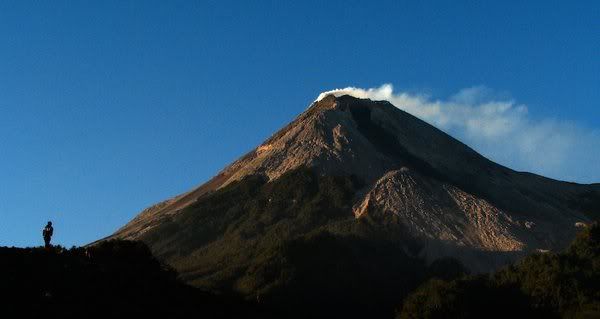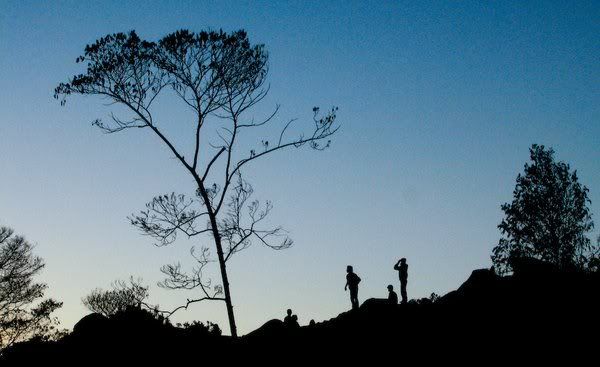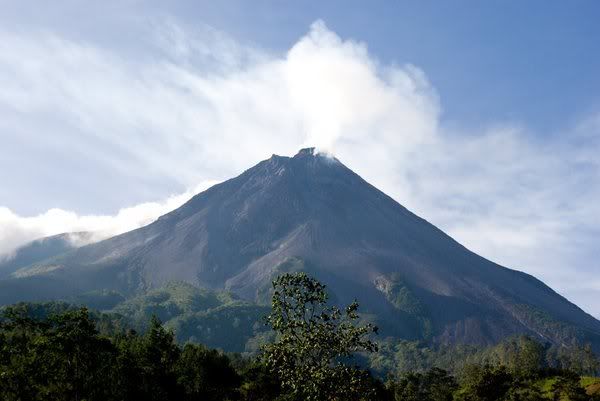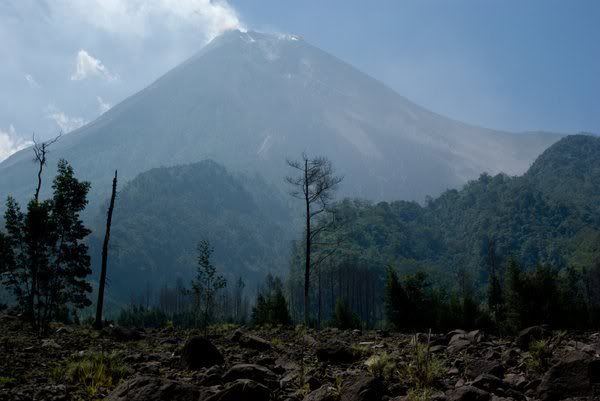Barong Temple
If you are interested in enjoying the holidays by visiting the temple, you’ll want to enjoy the charm of other temples are not less interesting than the Borobudur Temple or Prambanan. Have a look at Barong Temple, one of the unique temples located in the south of Prambanan, precisely in the hills Sambirejo Village, Prambanan District, Sleman regency.
Unlike other Hindu temple as the place to worship Lord Shiva (the god of destruction), Barong Temple is a complex of worship to worship the god Vishnu and his wife, Goddess Lakshmi or known by the name of Dewi Sri (the goddess of fertility for agriculture). Worship of Lord Vishnu and Goddess Sri is, according to Dra. Andi Riana (Unit Head Barong Temple) probably caused by the condition of the land around the temple are barren and infertile. Thus, by worshiping Lord Vishnu and Goddess Sri expected to become fertile soil conditions.
This temple complex was discovered by the Dutch around 1913, when perluasaan cane plantations to support the production of sugar mills. At that time, the temple still in ruins and difficult to identify its original form. New in the 1970’s restoration project underway. Stacking-and-error process of the temple started in 1978, and finally succeeded in restoring the building the first temple in 1994. In subsequent years, the restoration was held on the second temple, the restoration of the fence, and the restoration of Talut (the edge of sloping temple complex).
Barong temple complex has three terraces. The first terrace is the temple’s outer pages, bordered by stone lines which are blank areas that are considered profane. The second terrace is above the first terrace is composed of piles of stones. On the second terrace was found several octagonal stone base, which are thought to be the foundation of the pavilion building made of wood. The second terrace is regarded as an area of semi-profane. While the third terrace is an area that is considered sacred, where there are two temples: the first temple to worship the god Vishnu, while the second temple to worship the Goddess Sri. The third terrace is the highest area, where to enter it, visitors must pass through the stairs and a gate which is composed of andesite stone.
According to Andi Riana, based on archaeological data, the two temples are not built at the same time, but a lapse of several years after the first temple completed. This is evident from the widening Talut conducted at the time of building a second temple. Barong Temple complex is expected to be built around the 9th century to 10 AD. The shape and size of the two temples are almost the same. The first temple measuring 8.20 mx 8.20 m with a height of 9.25 m, while the second temple, measuring 8.25 mx 8.25 m with a height of 9.25 m.
Visit Barong Temple, you will find some uniqueness that can not be found in the temples of other Hindu religious relics in Yogyakarta and Central Java. The first is the uniqueness of kala makara ornament in the form of a lion’s head (barong), which has a lower jaw. Kala makara decoration usually carved above the door or the recesses of the temple as a symbol against disaster. Decoration barong in other temples in Yogyakarta and Central Java, usually only describe the face of a lion without a lower jaw, so that the decoration on the temple Barong is seen quite special. Probably because that’s pretty special this temple was nicknamed Barong Temple by surrounding communities. Barong same decoration was also present in several temples in East Java, whose age was younger (created in the kingdom and the Majapahit Kingdom Singosari).
In this temple also found some statues of Lord Vishnu and Goddess Sri. It is estimated that these statues had been placed in the recesses of the temple (false door), because Barong Temple do not have the room. Currently statues are kept in the Central Conservation of Archaeological Heritage (BP3) Sleman regency. Other decoration is quite unique is the relief of Ghana and Sankha winged. Ghana is the ornament of a dwarf creatures that sustain or support the recesses of the temple. While the winged Sankha is one of the symbols of Lord Vishnu. The presence of this winged Sankha relief reinforces the assumption that this temple is a place of worship of the god Vishnu, not Shiva as in most other Hindu temples.
About 100 meters southeast of Barong Temple Dawangsari temple ruins, which is a Buddhist temple. Second nearby temple building different religions illustrate that by then had built a harmonious life among the followers of different religions.
Barong Temple is located in the hamlet Candisari, Sambirejo Village, Prambanan District, Sleman District, Yogyakarta Province, Indonesia. From the city of Yogyakarta, Barong Temple is located approximately 27 kilometers to the east. Tourists will visit the Temple of Barong to take the route through the Prambanan temple using the Trans-Jogja bus (Route 1 A or 1 B) or use a taxi service. From the Prambanan temple is located on the edge of Yogyakarta-Solo road, tourists can take a southern direction (to the right when departing from Yogyakarta, or to the left if from the direction of Solo) up until T-junction that shows direction and Barong Temple Banyunibo. From this fork simply follow the directions to Barong Temple. However, if worried about getting lost, you should ask the local people. Prambanan Temple Of Barong towards tourists can take advantage of motorcycle taxi or cab, for other public transport are not yet available.
Currently, tourists visiting the Temple Barong is free. Tourists simply put the data themselves in the guest book located at Pos Jaga Barong Temple. However, the future of Culture and Tourism District. Sleman is planning to attract retribution for visitors.
Sightseeing Barong Temple is still limited facilities. However, for you are very interested in visiting or studying Barong Temple, to contact Pos Jaga Barong Temple Unit located at the entrance to the temple area. The officers in this office will provide information about the history of Barong Temple. If need lodging and restaurants, tourists can get around Prambanan.
Unlike other Hindu temple as the place to worship Lord Shiva (the god of destruction), Barong Temple is a complex of worship to worship the god Vishnu and his wife, Goddess Lakshmi or known by the name of Dewi Sri (the goddess of fertility for agriculture). Worship of Lord Vishnu and Goddess Sri is, according to Dra. Andi Riana (Unit Head Barong Temple) probably caused by the condition of the land around the temple are barren and infertile. Thus, by worshiping Lord Vishnu and Goddess Sri expected to become fertile soil conditions.
This temple complex was discovered by the Dutch around 1913, when perluasaan cane plantations to support the production of sugar mills. At that time, the temple still in ruins and difficult to identify its original form. New in the 1970’s restoration project underway. Stacking-and-error process of the temple started in 1978, and finally succeeded in restoring the building the first temple in 1994. In subsequent years, the restoration was held on the second temple, the restoration of the fence, and the restoration of Talut (the edge of sloping temple complex).
Barong temple complex has three terraces. The first terrace is the temple’s outer pages, bordered by stone lines which are blank areas that are considered profane. The second terrace is above the first terrace is composed of piles of stones. On the second terrace was found several octagonal stone base, which are thought to be the foundation of the pavilion building made of wood. The second terrace is regarded as an area of semi-profane. While the third terrace is an area that is considered sacred, where there are two temples: the first temple to worship the god Vishnu, while the second temple to worship the Goddess Sri. The third terrace is the highest area, where to enter it, visitors must pass through the stairs and a gate which is composed of andesite stone.
According to Andi Riana, based on archaeological data, the two temples are not built at the same time, but a lapse of several years after the first temple completed. This is evident from the widening Talut conducted at the time of building a second temple. Barong Temple complex is expected to be built around the 9th century to 10 AD. The shape and size of the two temples are almost the same. The first temple measuring 8.20 mx 8.20 m with a height of 9.25 m, while the second temple, measuring 8.25 mx 8.25 m with a height of 9.25 m.
Visit Barong Temple, you will find some uniqueness that can not be found in the temples of other Hindu religious relics in Yogyakarta and Central Java. The first is the uniqueness of kala makara ornament in the form of a lion’s head (barong), which has a lower jaw. Kala makara decoration usually carved above the door or the recesses of the temple as a symbol against disaster. Decoration barong in other temples in Yogyakarta and Central Java, usually only describe the face of a lion without a lower jaw, so that the decoration on the temple Barong is seen quite special. Probably because that’s pretty special this temple was nicknamed Barong Temple by surrounding communities. Barong same decoration was also present in several temples in East Java, whose age was younger (created in the kingdom and the Majapahit Kingdom Singosari).
In this temple also found some statues of Lord Vishnu and Goddess Sri. It is estimated that these statues had been placed in the recesses of the temple (false door), because Barong Temple do not have the room. Currently statues are kept in the Central Conservation of Archaeological Heritage (BP3) Sleman regency. Other decoration is quite unique is the relief of Ghana and Sankha winged. Ghana is the ornament of a dwarf creatures that sustain or support the recesses of the temple. While the winged Sankha is one of the symbols of Lord Vishnu. The presence of this winged Sankha relief reinforces the assumption that this temple is a place of worship of the god Vishnu, not Shiva as in most other Hindu temples.
About 100 meters southeast of Barong Temple Dawangsari temple ruins, which is a Buddhist temple. Second nearby temple building different religions illustrate that by then had built a harmonious life among the followers of different religions.
Barong Temple is located in the hamlet Candisari, Sambirejo Village, Prambanan District, Sleman District, Yogyakarta Province, Indonesia. From the city of Yogyakarta, Barong Temple is located approximately 27 kilometers to the east. Tourists will visit the Temple of Barong to take the route through the Prambanan temple using the Trans-Jogja bus (Route 1 A or 1 B) or use a taxi service. From the Prambanan temple is located on the edge of Yogyakarta-Solo road, tourists can take a southern direction (to the right when departing from Yogyakarta, or to the left if from the direction of Solo) up until T-junction that shows direction and Barong Temple Banyunibo. From this fork simply follow the directions to Barong Temple. However, if worried about getting lost, you should ask the local people. Prambanan Temple Of Barong towards tourists can take advantage of motorcycle taxi or cab, for other public transport are not yet available.
Currently, tourists visiting the Temple Barong is free. Tourists simply put the data themselves in the guest book located at Pos Jaga Barong Temple. However, the future of Culture and Tourism District. Sleman is planning to attract retribution for visitors.
Sightseeing Barong Temple is still limited facilities. However, for you are very interested in visiting or studying Barong Temple, to contact Pos Jaga Barong Temple Unit located at the entrance to the temple area. The officers in this office will provide information about the history of Barong Temple. If need lodging and restaurants, tourists can get around Prambanan.











 Read more: http://epg-studio.blogspot.com/2009/06/widget-pengatur-halaman-untuk-kembali.html#ixzz1UA3ocoWT
Read more: http://epg-studio.blogspot.com/2009/06/widget-pengatur-halaman-untuk-kembali.html#ixzz1UA3ocoWT